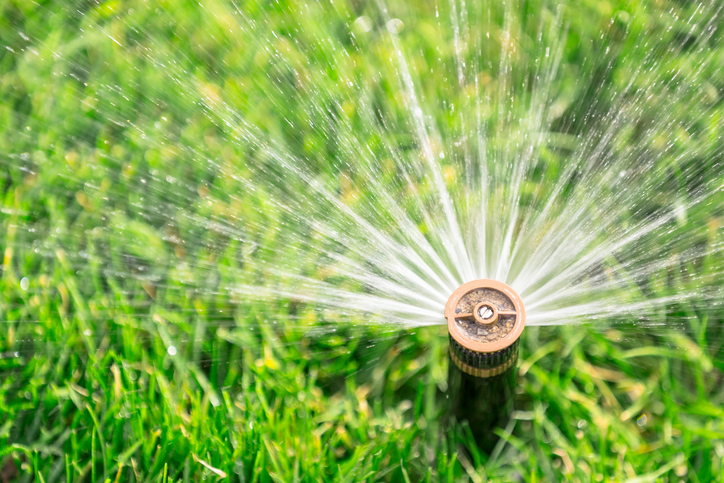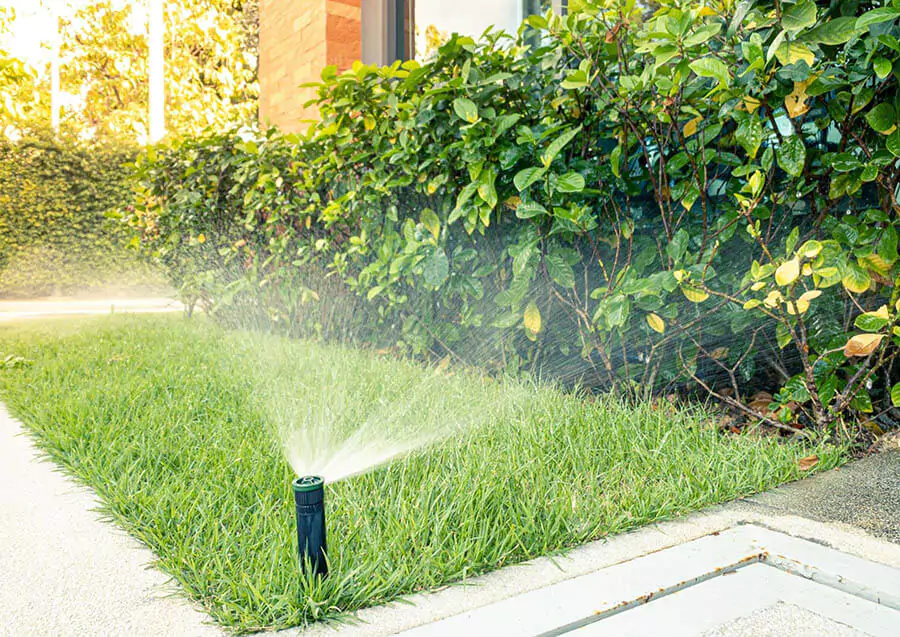If experiencing low water pressure when your sprinklers are active, several potential causes may be at play. First, check the water pressure regulator near your main water line for any need for adjustments or replacement. Inspect your sprinkler system thoroughly for leaks, blockages, or damaged components that might impede water flow.
Ensure all water valves linked to the sprinkler system are fully open. Consider whether the size of the water supply line could be insufficient for simultaneous use, potentially necessitating an upgrade to a larger diameter line.
Problems with pressure tanks or well pumps, if applicable, should also be investigated. Managing water usage by staggering high-water-consuming appliances might also help balance water distribution during sprinkler use.
What are the key steps for effective initial checks and basic inspections?

Performing initial checks and basic inspections can help identify common issues related to low water pressure when the sprinklers are on. Here are the key steps for an effective inspection:
Visual Inspection of Sprinkler Heads
Examine all the sprinkler heads for visible damage, such as clogs, blockages, or broken components. Clean any debris that might obstruct water flow and replace any damaged parts.
Check Water Pressure Gauge
If your sprinkler system has a pressure gauge, monitor it while the system is running. Ensure the pressure remains within the recommended range specified for your system. If it fluctuates significantly, it could indicate an issue.
Inspect Pipes and Valves
Follow the irrigation lines and inspect pipes, valves, and connections for leaks, cracks, or signs of damage. Even small leaks can lead to reduced water pressure.
Examine Control Valves
Check all control valves to ensure they’re fully open and functioning correctly. Partially closed valves can restrict water flow and cause pressure drops.
Evaluate the Water Supply
Verify that the main water supply to the sprinkler system is fully open and not obstructed. Ensure there are no other appliances or systems drawing an excessive amount of water concurrently, affecting overall pressure.
Test Pressure Regulator (if applicable)
If your system has a pressure regulator, test it to ensure it’s properly regulating the water pressure. Adjust it if necessary to maintain the optimal pressure for your sprinkler system.
Check for Underground Leaks
Inspect the areas around sprinkler heads for soggy or overly wet patches of soil, which might indicate underground leaks. Use a leak detection device or hire a professional to identify and fix these leaks.
Verify Controller Settings
Review the settings on your sprinkler system controller to ensure there are no programming errors that could be causing inefficiencies or overloading the system.
Evaluate Water Pump (if applicable)
For systems using a water pump, check the pump’s condition, pressure settings, and functionality. A malfunctioning pump can lead to decreased water pressure.
Consult System Documentation
Refer to the user manual or system documentation to ensure all components are installed and functioning correctly according to the manufacturer’s specifications.
How to assess water supply and system configuration effectively?
Assessing water supply and system configuration for your sprinkler system involves several steps to ensure optimal performance and identify potential issues. Here’s a guide on how to effectively assess these aspects:
Water Supply Assessment
Flow Rate and Pressure
Measure the water flow rate and pressure at various points in the system. You can use a water pressure gauge and a flow meter to check the pressure and flow rates at different zones or sprinkler heads. Compare these measurements with the recommended levels for your sprinkler system.
Check for Water Quality
Assess the quality of the water supply. High mineral content or sediment in the water can lead to clogged sprinkler heads and pipes. Install filters if necessary to improve water quality and prevent blockages.
Assess Water Source
Determine the water source for your sprinkler system, whether it’s municipal water, well water, or another source. Each source might have specific considerations for pressure, quality, and maintenance.
Evaluate Water Supply Capacity
Verify that the water supply can meet the demand of your sprinkler system. Calculate the total water demand of your system based on the number of zones, sprinkler types, and their flow rates to ensure your supply can handle it.
System Configuration Assessment
Layout and Design
Review the layout and design of your sprinkler system. Ensure it’s designed to effectively cover the entire area without overlapping or leaving dry spots. Consider the types of sprinkler heads used in different zones and their distribution patterns.
Zone Distribution
Evaluate the zoning of your system. Ensure zones are appropriately divided based on water needs and hydraulic capacity. Avoid having too many sprinkler heads in a single zone, which can lead to pressure drops.
Valve and Controller Settings
Check the settings on the control valves and the irrigation controller. Ensure they are programmed correctly to run at optimal times and durations for each zone. Make adjustments if needed to balance water distribution.
Check for Leaks or Damage
Inspect the entire system for leaks, damaged pipes, or malfunctioning valves. Even minor leaks can significantly reduce water pressure and affect the system’s efficiency.
Evaluate Backflow Prevention
Confirm that your system has appropriate backflow prevention devices installed and that they are functioning correctly to prevent contamination of the water supply.
What are the essential troubleshooting steps to resolve issues?

When troubleshooting issues with your sprinkler system causing low water pressure or other problems, follow these essential steps to identify and resolve the issues:
Identify the Problem
- Observe the symptoms carefully, such as low water pressure, uneven watering, or leaks.
- Determine if the issue affects the entire system or specific zones.
Inspect the System
- Check all sprinkler heads, pipes, valves, and fittings for leaks, blockages, or damage.
- Look for signs of uneven water distribution or areas with excessive dryness.
Check Water Supply
- Verify that the main water supply to the system is open and delivering sufficient pressure.
- Measure the water pressure at different points in the system using a pressure gauge.
Assess Controller Settings
- Review the settings on the irrigation controller to ensure proper scheduling and run times for each zone.
- Confirm that the controller is functioning correctly and not causing overwatering or under-watering.
Inspect Valves and Zones
- Check all control valves to ensure they are fully open and not malfunctioning.
- Test individual zones to verify that each one is receiving adequate water pressure.
Address Clogs or Blockages
- Clear any clogged sprinkler heads or nozzles using a cleaning tool or by disassembling and cleaning the parts.
- Flush out debris from pipes or filters that may be causing blockages.
Repair Leaks or Damaged Components
- Fix any leaks in pipes, fittings, or valves by replacing damaged components.
- Ensure proper sealing and connections to prevent water loss.
Adjust Sprinkler Heads
- Check the alignment and positioning of sprinkler heads to ensure they cover the intended area without overspray or dry spots.
- Adjust the direction, arc, or distance of the heads if necessary.
FAQ’s
Why does my water pressure drop when two faucets are on?
Water pressure can drop when multiple faucets are on due to the shared water supply. The demand exceeds the supply capacity, reducing pressure across the system.
Do I need a pressure regulator for sprinklers?
A pressure regulator helps stabilize and maintain consistent water pressure in sprinkler systems, especially if the incoming pressure is too high. It’s recommended for proper operation.
How much water does a sprinkler use in 30 minutes?
Sprinkler water usage varies based on the sprinkler type, nozzle size, and water pressure. Typically, a sprinkler can use around 500 to 1,000 gallons per hour.
How much pressure loss per sprinkler head?
Pressure loss per sprinkler head depends on factors like the sprinkler type, nozzle size, and layout. On average, each sprinkler head might cause a pressure loss of 5-10 pounds per square inch (psi).
How far should sprinklers be from the house?
Sprinklers should be positioned to water the lawn or plants adequately without hitting the house. A general rule is to place sprinklers at least 6 feet away from the house to avoid water damage.
How do I check my sprinkler pressure?
Use a pressure gauge designed for irrigation systems. Connect it to a hose bib or a sprinkler head and turn on the system to measure the pressure during operation.
Final Words
In troubleshooting low water pressure issues during sprinkler use, a systematic approach is vital. Begin by checking the pressure regulator for adjustments and examining the entire system for leaks or blockages. Ensure full valve openings and consider a larger water supply line if needed. Assessing pressure tanks, optimizing water usage, and inspecting the water pump or well are crucial steps. Effectively evaluate system components, controller settings, and perform meticulous water supply assessments.
Additionally, a methodical inspection of sprinkler heads, pipes, and valves coupled with a thorough assessment of system configuration aids in pinpointing issues. This systematic troubleshooting process ensures a comprehensive resolution of sprinkler-related water pressure problems.
